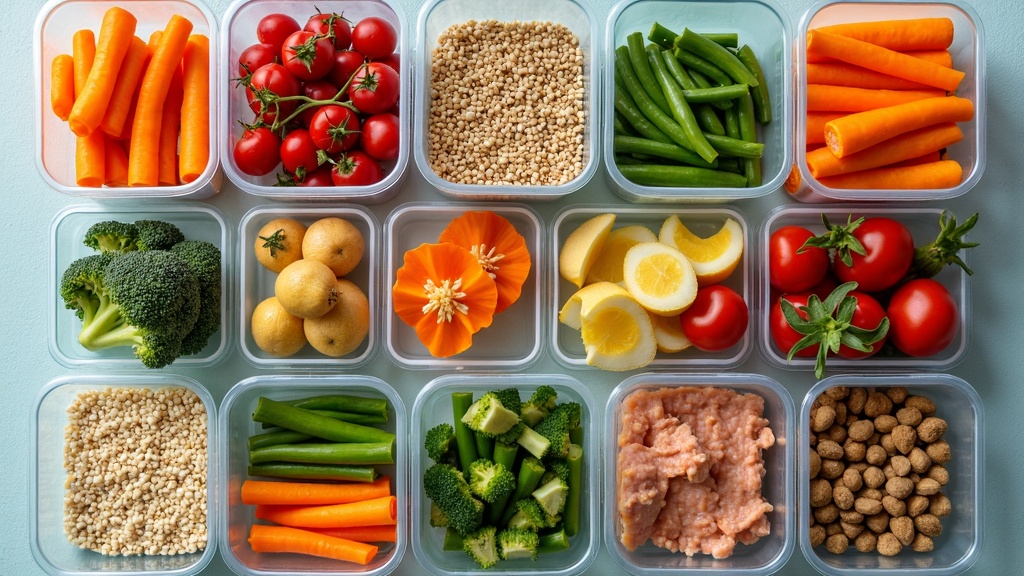Meal planning is one of those habits that can help keep my diet balanced and my day on track. When I take time to plan out my meals, I find it much easier to eat well and avoid those last-minute choices that might not be the best for my body. Having a plan also saves me time and money. It reduces food waste in my kitchen. So, I want to share my best tips for meal planning that can lead to a balanced diet and make everyday eating a little smoother.

Why Meal Planning Matters For a Balanced Diet
Planning meals a few days or even a week ahead gives me a clearer view of what I’ll be eating. I can make sure I’m including different food groups, getting enough nutrients, and not overloading on any one ingredient. Even on busy days, sticking to my plan helps me avoid reaching for snacks that don’t really fill me up.
Eating a balanced diet includes a mix of vegetables, fruit, whole grains, protein, and healthy fats. According to the CDC, healthy eating patterns are linked to better overall health and can help manage weight and lower risk of chronic illnesses. By planning my meals, I can see if I’m getting a bit of everything and make changes if I notice gaps in my diet. I sometimes go back and check out my meal notes from previous weeks too, to see what worked best for me and adjust my plan if needed.
Simple First Steps For Getting Started
When I first started meal planning, keeping things simple made it a lot easier to stick with it. Writing it down, either on paper or in a digital note, clarified my week and removed the guesswork from each day. Here are the steps I follow each week:
- Pick a Planning Day: I set aside a specific day each week to make my plan; usually Sunday afternoon.
- Check What I Have: I take inventory of what’s already in my fridge, freezer, and pantry. This helps me use up leftovers and avoid buying extra food I don’t need.
- Set a Realistic Menu: I try to include my favorite easy recipes, maybe one new dish, and foods that work well for leftovers.
- Create a Shopping List: I write out only what I need, based on my menu and what I already have at home.
- Leave Room for Flexibility: Some days I just won’t feel like eating what I planned, so swapping meals around is normal for me.
If you want to take your organization up a notch, you could also color-code your plan, assign meals for breakfast, lunch, and dinner in different columns, or add snack ideas to your planning list. Sometimes, I also jot down notes for busy days so I can quickly see which meals are best suited for those times, making it even more manageable.
Meal Planning Basics: What Makes a Meal Balanced?
A balanced meal is about combining a few main types of foods at each meal. I keep an eye out for the following at breakfast, lunch, and dinner:
- Protein: Chicken, eggs, tofu, fish, beans, or lentils. I know protein helps me feel full and keeps my energy steady.
- Vegetables: I fill at least half my plate with colorful vegetables, either cooked or raw. This adds fiber, vitamins, and minerals.
- Whole Grains: Brown rice, quinoa, oats, or whole wheat bread instead of white breads and pastas.
- Healthy Fats: Things like avocado, olive oil, nuts, and seeds. They support my brain and keep my meals satisfying.
- Fruits: I like to include a fruit as a side or dessert; this is a simple way to add vitamins and fiber.
Using these groups as my guide, I can easily put together meals that keep me satisfied and energized throughout the day. For example, a typical lunch might be grilled chicken over brown rice with roasted vegetables and sliced avocado, finished off with a side of berries, which always checks off all the right boxes for me.
Meal Prep: Making Meal Planning Work For You
Taking some time to prep ingredients ahead makes it a lot easier for me to stick to my plan. Sometimes I cook grains or chop vegetables for the week all at once. Even washing salad greens and portioning out snacks can save me time later. Here are some meal prep tricks I use:
- Chop and store vegetables for stirfries, salads, or snacks.
- Batchcook proteins like grilled chicken, boiled eggs, or roasted tofu, so they’re ready for quick meals.
- Cook a large pot of brown rice, quinoa, or another whole grain early in the week.
- Portion out meals in containers so I can grab and go if my day gets busy.
I usually keep some “emergency” meal options in my freezer, like homemade soups, chili, or a bag of frozen vegetables I can toss into any dish in a pinch. Prepping even a single element in advance, like chopped onions or prewashed greens, often makes a huge difference in my willingness to cook later.
The Importance of Variety and Color In Planning Meals
I notice that adding lots of color to my plate not only looks more appealing—it often means I’m getting a range of nutrients. Including different colored fruits and vegetables, such as leafy greens, red peppers, orange carrots, and blue or purple berries, provides different vitamins, minerals, and antioxidants.
Rotating my proteins and grains stops me from getting bored. Sometimes I’ll plan a “theme” week, like Mexican inspired dishes, or I’ll build meals around what’s fresh and in season. This variety keeps things interesting and helps cover my nutritional bases. I even try global cuisines every now and then, whether that’s a stirfry with lots of coconut, an Italian risotto, or a curry with lentils and spinach. Mixing up herbs, spices, or sauces can make the same base ingredients taste exciting in new ways.
Common Meal Planning Challenges and How I Handle Them
Of course, meal planning isn’t always perfect. I often run into a few issues, so I’ve found some solutions that work for me:
- Running Out of Time: I keep a few really quick recipes or pantry staples, like canned beans or microwavable rice, on hand for nights when I need something fast.
- Boredom With Meals: Every so often, I’ll try a new recipe from a blog or a cookbook, just to mix things up. Cooking with a friend or family member can make the experience fresh, and we might even stumble upon a new favorite dish together.
- Changing Schedules: If my plans change, moving a meal to another day or freezing leftovers stops food from going to waste.
- Family Preferences: When I plan for others, I offer choices or let each person pick a meal for the week, so everyone feels included in the plan. We might make a “build your own” night, like taco bowls or pizza, to suit everyone’s taste.
Cutting Down on Food Waste
Meal planning really helps reduce how much food I throw out. By using up produce before it goes bad and repurposing leftovers, I feel better about making use of what I buy. If I end up with odds and ends, I’ll make a stirfry, soup, or omelet with what’s left over. Freezing small leftovers in single-portion containers saves me on busy days too.
Making Grocery Shopping Easier
Having a precise shopping list makes grocery trips so much faster. I also find that sticking to a list keeps my bill lower, since I’m less tempted to toss random things in my cart. If there’s a sale on something that fits into my menu, I’ll grab extra and freeze it for later meals. If I shop online, I can quickly search for what’s on my list, which helps me avoid unnecessary extras, and comparing prices is easier than ever.
Advanced Meal Planning: Tips For Long Term Success
Once I built the meal planning habit, I found some ways to keep it interesting and even save more time:
- Theme Nights: Choosing categories like Taco Tuesday, Pasta Wednesday, or Stirfry Friday gives my week a rhythm and makes planning really easy.
- Double Up and Freeze: When I cook a meal, I make a double batch and freeze half for a future busy day. This also works for breakfast items like oatmeal bakes or muffins, which I freeze and defrost as needed.
- Rotate Favorite Recipes: Keeping a list of meals I love in my phone or notebook saves time when I’m out of ideas. I’ll bring back favorites regularly. Sometimes I find inspiration from social media or friends’ recommendations, which adds a fun twist.
- Use Technology: Apps and websites let me organize recipes and build grocery lists. Some even suggest meals based on what I have at home. Digital meal planners can send reminders for thawing, prepping, or shopping, which helps streamline my week even more.
With these tricks, meal planning feels less like a chore and more like a helpful way to make eating well really doable. If I ever slip out of the habit, I just pick it back up the next week. No guilt needed. The key is to keep it simple and flexible; plans can always be adjusted as life changes.
Meal Planning FAQs
Here are some common questions people ask me about meal planning:
Question: How far ahead should I plan meals?
Answer: For me, one week is enough. It gives me structure without making things too rigid. Some people like planning three or four days ahead if their schedule changes a lot.
Question: How do I add more vegetables to my meals?
Answer: I focus on adding vegetables to every meal, even breakfast—like spinach in an omelet. Snacking on cut up vegetables with hummus makes it even easier. I also try to blend extra greens into smoothies or cook double the vegetables for dinner and have some left for lunch the next day.
Question: What if my meals get repetitive?
Answer: Trying a new recipe every week, even something small like a new salad dressing or new way to cook chicken, keeps things interesting. Fresh herbs and spices can really make a big difference too. Joining an online recipe group for more inspiration works wonders when I’m out of ideas.
How Meal Planning Has Helped Me
When I stick with meal planning, I find I eat better, feel better, and my week feels a lot less stressful. I waste less food, save money, and enjoy what I eat more. It doesn’t have to be complicated. Even a simple plan with two or three meal ideas for the week can make a big difference. If one meal doesn’t work out, it’s okay to switch things up or order takeout, with no guilt attached. The focus is on progress, not perfection.
With a bit of practice and some flexibility, meal planning fits into almost any schedule. It’s a skill I keep coming back to because it just works. Keeping my meals balanced helps support my health, and planning is what really makes that possible for me. Wrapping up, meal planning is not just about food—it’s a small step that adds up to big changes in how I feel, spend, and eat every day.
